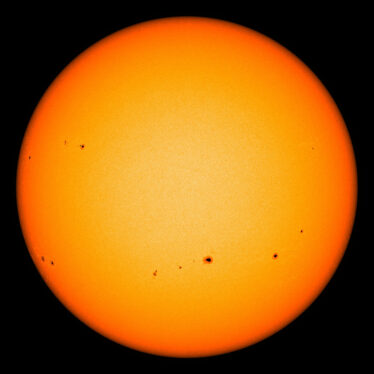Guessing your age might be a popular carnival game, but for astronomers it’s a real challenge to determine the ages of stars. Once a star like our Sun has settled into steady nuclear fusion, or the mature phase of its life, it changes little for billions of years. One exception to that rule is the star’s rotation period – how quickly it spins. By measuring the rotation periods of hundreds of thousands of stars, NASA’s Nancy Grace Roman Space Telescope promises to bring new understandings of stellar populations in our Milky Way galaxy after it launches by May 2027.
Stars are born spinning rapidly. However, stars of our Sun’s mass or smaller will gradually slow down over billions of years. That slowdown is caused by interactions between a stream of charged particles known as the stellar wind and the star’s own magnetic field. The interactions remove angular momentum, causing the star to spin more slowly, much like an ice skater will slow down when they extend their arms.
This effect, called magnetic braking, varies depending on the strength of the star’s magnetic field. Faster-spinning stars have stronger magnetic fields, which causes them to slow down more rapidly. Due to the influence of these magnetic fields, after about one billion years stars of the same mass and age will spin at the same rate. Therefore, if you know a star’s mass and rotation rate, you potentially can estimate its age. By knowing the ages of a large population of stars, we can study how our galaxy formed and evolved over time.
Measuring Stellar Rotation
How do astronomers measure the rotation rate of a distant star? They look for changes in the star’s brightness due to starspots. Starspots, like sunspots on our Sun, are cooler, darker patches on a star’s surface. When a starspot is in view, the star will be slightly dimmer than when the spot is on the far side of the star.

If a star has a single, large spot on it, it would experience a regular pattern of dimming and brightening as the spot rotated in and out of view. (This dimming can be differentiated from a similar effect caused by a transiting exoplanet.) But a star can have dozens of spots scattered across its surface at any one time, and those spots vary over time, making it much more difficult to tease out periodic signals of dimming from the star’s rotation.
Applying Artificial Intelligence
A team of astronomers at the University of Florida is developing new techniques to extract a rotation period from measurements of a star’s brightness over time, through a program funded by NASA’s Nancy Grace Roman Space Telescope project.
They are using a type of artificial intelligence known as a convolutional neural network to analyze light curves, or plots of a star’s brightness over time. To do this, the neural network first must be trained on simulated light curves. University of Florida postdoctoral associate Zachary Claytor, the science principal investigator on the project, wrote a program called “butterpy” to generate such light curves.

“This program lets the user set a number of variables, like the star’s rotation rate, the number of spots, and spot lifetimes. Then it will calculate how spots emerge, evolve, and decay as the star rotates and convert that spot evolution to a light curve – what we would measure from a distance,” explained Claytor.
The team has already applied their trained neural network to data from NASA’s TESS (Transiting Exoplanet Survey Satellite). Systematic effects make it more challenging to accurately measure longer stellar rotation periods, yet the team’s trained neural network was able to accurately measure these longer rotation periods using the TESS data.
Roman’s Star Survey
The upcoming Roman Space Telescope will gather data from hundreds of millions of stars through its Galactic Bulge Time Domain Survey, one of three core community surveys it will conduct. Roman will look toward our galaxy’s center – a region crowded with stars – to measure how many of these stars change in brightness over time. These measurements will enable multiple science investigations, from searching for distant exoplanets to determining the stars’ rotation rates.
The specific survey design is still being developed by the astronomical community. The NASA-funded study on stellar rotation promises to help inform potential survey strategies.
“We can test which things matter and what we can pull out of the Roman data depending on different survey strategies. So when we actually get the data, we’ll already have a plan,” said Jamie Tayar, assistant professor of astronomy at the University of Florida and the program’s principal investigator.
“We have a lot of the tools already, and we think they can be adapted to Roman,” she added.
The Nancy Grace Roman Space Telescope is managed at NASA’s Goddard Space Flight Center in Greenbelt, Maryland, with participation by NASA’s Jet Propulsion Laboratory and Caltech/IPAC in Southern California, the Space Telescope Science Institute in Baltimore, and a science team comprising scientists from various research institutions. The primary industrial partners are BAE Systems, Inc. in Boulder, Colorado; L3Harris Technologies in Melbourne, Florida; and Teledyne Scientific & Imaging in Thousand Oaks, California.
By Christine Pulliam
Space Telescope Science Institute, Baltimore, Md.
Media Contact:
Claire Andreoli
NASA’s Goddard Space Flight Center, Greenbelt, Md.
301-286-1940
Christine Pulliam
Space Telescope Science Institute, Baltimore, Md.




